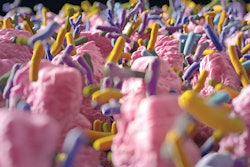
Find out how probiotics, prebiotics, phytogenics and enzymes can prevent clostridial disease
Necrotic enteritis is the most common clostridial disease and it causes significant economic losses in broilers, according to Brooke Jasek, technical sales manager, Quality Technology International Inc. (QTI). She spoke January 25 at the Feed Strategy Conference during the International Production & Processing Expo in Atlanta.
With 60% of broilers being produced in antibiotic-free production systems, alternative nutritional strategies must be used to combat necrotic enteritis.
“In the absence of using antibiotics, alternative feed ingredients are working to rebalance that microbial community to avoid proliferation of Clostridia,” Jasek said. “These nutritional strategies can include prebiotics, probiotics, phytogenics and enzymes, but those are only a few that are out there. And they’re great tools to be utilized to help combat or lessen that impact of necrotic in your flocks.”
-
Probiotics
Probiotics are live microbial feed supplements that benefit the animal by improving its microbial balance.
They reduce the number of mucosal binding sites for pathogenic bacteria “and what you see happen is almost a shift in that microflora,” Jasek said. “There’s a suppression of, say, E. coli, Salmonella, Clostridia, which allows the growth for beneficial bacteria such as Lactobacillus and Bifidobacterium.”
Probiotics stimulate the immune system and increase digestive enzyme activity such as amylase, lipase and protease, “which, as we all know, can help increase the nutrient absorption and utilization,” she said.
The ability of Bacillus subtilis to form spores allows it to survive harsh environments such as the feed milling process or long transport times. They also can tolerate the acidic conditions of the upper gastrointestinal (GI) tract and be released lower in the GI tract where they are most useful.
-
Prebiotics
Prebiotics are indigestible feed ingredients that selectively stimulate the growth of bacteria in the GI tract. They prevent colonization of pathogenic bacteria, lower gut pH via organic acid production and stimulate the immune system.
Jasek highlighted manno-oligosaccharides and fructo-oligosaccharides as working particularly well to prevent necrotic enteritis.
-
Phytogenics
Phytogenics are biologically active substances extracted from plants that express antimicrobial, antioxidant and anti-inflammatory properties.
“This group has grown recently in research and is continuing to grow,” Jasek said.
The most common plant extracts used to control Clostridia include thymol, carvacrol and cinnamaldehyde. A 2004 study found that a blend of thymol and carvacrol fed to broilers resulted in a reduction of Clostridium perfringens, “ultimately suggesting that, with a reduction in Clostridia, there was also a reduction in the severity of necrotic enteritis.”
They have a direct antimicrobial effect by penetrating and killing the bacterial cell wall and membranes. Also have an indirect effect on gut microflora modulation, as well as quorum sensing and quorum quenching
-
Enzymes
Cereals in the diet can increase the prevalence and severity of necrotic enteritis, Jasek said.
“It is important to consider your diet type, especially when we’re discussing diseases such as necrotic enteritis, or really any disease, because those cereal grains can impact that mucin production and digestive viscosity, which can lead to a whole host of problems, but the addition of enzymes can help reduce intestinal viscosity and improve the overall digestion,” she said.
She highlighted xylanase, amylase and beta-glucanase as particularly beneficial in this area. Xylanase especially can reduce digesta viscosity and lead to the removal of excess substrate. It can also have prebiotic-like effects through enzyme hydrolysis and has synergistic effects when combined with Bacillus subtilis by reducing the load of Clostridium perfringens in the litter.














